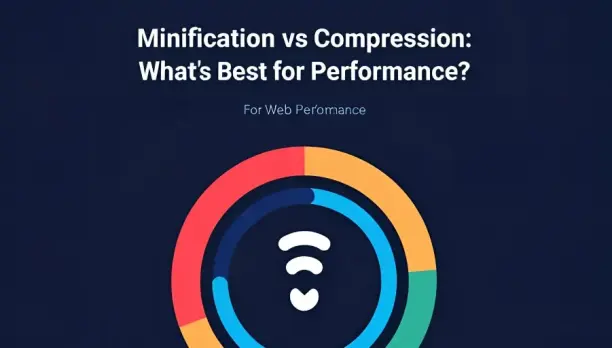Minification vs Compression: What’s Best for Web Performance?

🧠 Introduction
Website speed is more important than ever. Not only does it impact user experience, but it also affects SEO rankings, conversion rates, and bounce rates. Two critical techniques for optimizing web performance are minification and compression. Though often used together, they serve different purposes.
In this post, we’ll break down what minification and compression are, their key differences, when to use each, and the best tools for implementation.
⚡ What is Minification?
Minification is the process of removing unnecessary characters (like white space, comments, and formatting) from source code files such as HTML, CSS, and JavaScript. The goal is to reduce file size without changing functionality.
✅ Benefits of Minification:
-
Reduces file size
-
Speeds up page load
-
Improves Core Web Vitals (especially Largest Contentful Paint)
-
Saves bandwidth
🛠️ Popular Tools for Minification:
-
Terser (JS) – Advanced JavaScript minifier
-
cssnano (CSS) – Modular CSS minifier
HTMLMinifier (HTML) – Lightweight HTML reduction
-
Laravel Mix – Handles minification automatically for Laravel projects
📦 What is Compression?
Compression is a method of encoding data so it takes up less storage space and bandwidth during transmission. While minification modifies code structure, compression happens at the transport layer, often using formats like Gzip or Brotli.
✅ Benefits of Compression:
-
Shrinks file size drastically (even after minification)
-
Improves page speed and TTFB (Time To First Byte)
-
Works on all text-based files (HTML, CSS, JS, JSON, SVG)
🛠️ Common Compression Methods:
-
Gzip – Supported by all browsers, widely used
-
Brotli – Newer, better compression ratio, supported by modern browsers
-
Zopfli – Google’s advanced Gzip alternative for static content
💡 Enable Compression via:
-
Apache:
-
Nginx:
-
CDN Services: Cloudflare and Fastly apply automatic compression.
🔍 Minification vs Compression: Key Differences
| Feature | Minification | Compression |
|---|---|---|
| Layer | Code (build time) | Transport (runtime) |
| Purpose | Removes unnecessary characters | Encodes data to reduce size |
| Target Files | HTML, CSS, JS | HTML, CSS, JS, JSON, XML |
| Browser Support | No impact | Needs browser support (mostly yes) |
| Reversible | No (changes the original file) | Yes (decompressed by browser) |
🧪 Should You Use Both?
Absolutely.
Minification and compression work best together. Minify your source code during the build process, then apply Gzip or Brotli compression on the server or via a CDN. This layered approach ensures the smallest possible file size and the fastest load times.
🛠️ Tools That Do Both:
-
Webpack: JavaScript bundler with built-in minification plugins
-
Laravel Mix: Minifies and prepares assets for compression
-
Google PageSpeed Module: Automatically rewrites and compresses resources
-
Vite: Lightning-fast frontend build tool with modern minification support
🔗 Useful Resources
✅ Final Thoughts
Minification and compression are essential performance strategies for modern websites. While they solve different problems, combining both will drastically reduce load time, improve SEO rankings, and enhance user experience.
In 2025, web performance is a ranking factor and a user expectation. Implement minification during your build and use Brotli or Gzip on your server to deliver fast, optimized experiences.
Start optimizing today, and make your site not just functional—but fast and efficient.

Leave a comment